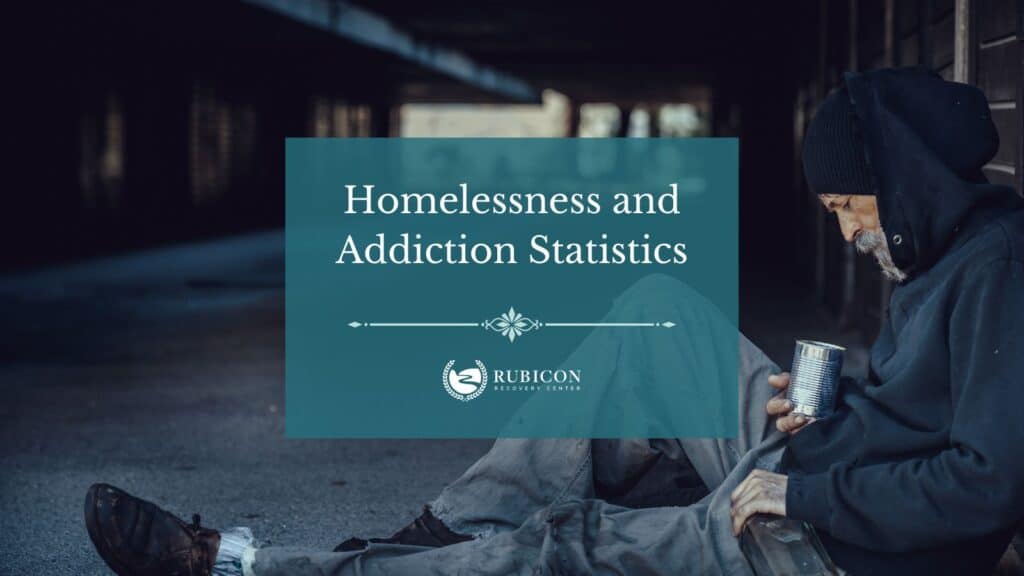Struggling to find a safe place to sleep at night and battling an addiction are challenges no one should face. Yet, these are harsh realities for a significant number of the homeless population in the United States.
With limited access to affordable housing, economic instability, and inadequate support systems, individuals facing homelessness are at increased risk of substance abuse and addiction.
Here are some key statistics that shed light on the prevalence of substance abuse among homeless individuals and the various demographics most affected.
KEY TAKEAWAYS:
- According to the United States Department of Housing and Urban Development (HUD) 2022 report, 21% of homeless individuals acknowledge severe mental illness, while 16% report a substance use disorder.
- Approximately 257,000 homeless individuals suffer from severe mental illness or chronic substance abuse, as per HUD’s 2013 report.
- Substance abuse is cited as a leading cause of homelessness among single adults by 68% of mayors, based on a 2008 survey by the United States Conference of Mayors.
- Statista’s 2022 data reveals there are 30,393 homeless individuals with chronic substance abuse in emergency shelters.
- Drug overdoses, primarily involving opioids, account for one-third of deaths among homeless individuals under 45, as found in a Boston study from 1988 to 2008.
- According to a 2019 JAMA-published survey, homeless patients in New York City’s public emergency departments exhibit a much higher likelihood of heroin and prescription opioid use compared to non-homeless counterparts.
- In Los Angeles, 22% of homeless youth misuse prescription drugs, based on a 2014 study in Drug and Alcohol Dependence.
- Veterans experiencing homelessness have higher rates of substance use disorders and mental health issues, as per a 2012 Veterans Health Administration (VHA) study.
- According to HUD, homeless individuals often face dual diagnoses of addiction and mental health disorders, with approximately 20% suffering from severe mental illness.
- Substance use and HIV/AIDS contribute to one-third of deaths among adults using DHS shelters, as reported by the NYC Department of Health and Mental Hygiene.
- The National Association of State Alcohol and Drug Abuse Directors (NASADAD) estimated over 19.3 million needing addiction treatment in 2005 faced barriers such as high costs and lack of insurance coverage.
General Insights
Here are some general insights into homelessness and addiction:
- According to the 2022 Annual Homeless Assessment Report to Congress by the U.S. Department of Housing and Urban Development, 21% of homeless people acknowledged having a severe mental illness, while 16% reported having a substance use disorder.
- Based on the 2013 Annual Homeless Assessment Report to Congress, approximately 257,000 individuals experiencing homelessness suffered from either a severe mental illness or a chronic substance abuse problem.
- In a 2008 survey conducted by the United States Conference of Mayors, 25 cities were asked to identify the primary causes of homelessness in their areas. 68% of mayors cited substance abuse as the leading cause of homelessness among single adults. Substance abuse was also identified as one of the top three causes of family homelessness in 12% of the cities surveyed.
- The table below provides estimates for the number of homeless individuals with chronic substance abuse in the United States in 2022, categorized by sheltered status.
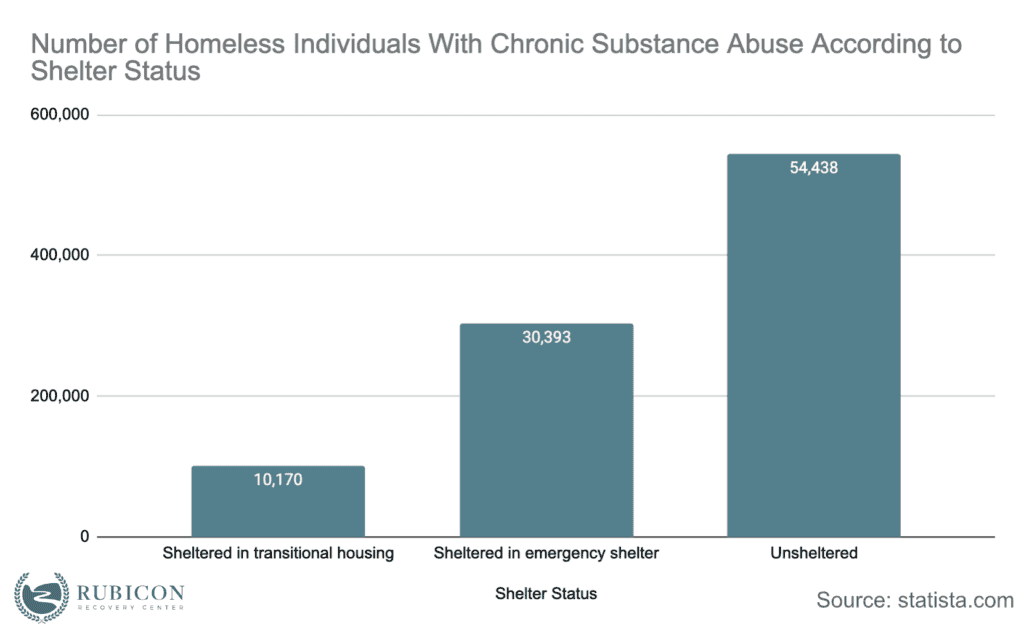
Homelessness and Addiction Statistics by Drug
Here are some statistics about the type of drugs involved in homeless addiction:
- The National Coalition for the Homeless highlights that alcohol abuse is prevalent among homeless populations, particularly in older adults. Data collected from seven Western countries indicates that the predominant substance use disorder among homeless individuals is alcohol dependence.
- Research carried out in Boston from 1988 to 2008 and published in JAMA Internal Medicine revealed that one-third of deaths among homeless individuals under the age of 45 were linked to drug overdoses, with opioids being involved in 81% of these fatalities.
- In a 2018 Drug Alcohol Dependance survey conducted at a public emergency department in New York City, homeless patients exhibited a greater likelihood of using heroin and prescription opioids compared to patients with stable housing.
- According to a 2019 state-level Youth Risk Behavior Survey (YRBS) published in JAMA, homeless adolescents were far more likely to use drugs than non-homeless ones. Here’s a breakdown of the drugs used by homeless adolescents who participated in the survey:
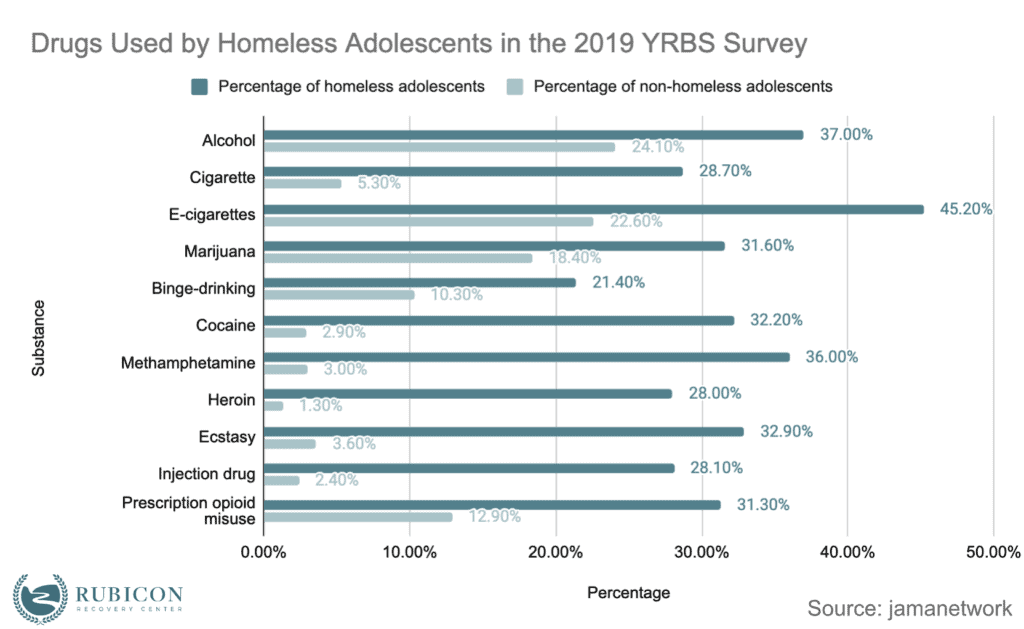
- A study published in Drug and Alcohol Dependence in 2014 found that out of 457 homeless youth in Los Angeles, 22 percent were presently misusing prescription drugs.
Homelessness and Addiction Statistics by Demographics
Here are homelessness and addiction statistics for veterans, women, and young adults:
Veterans
- Data from 256,404 veterans who were homeless or had opioid use disorder (OUD) in 2012 were studied to understand the relationship between OUD and homelessness. Nearly 18% of veterans were diagnosed with OUD, and 35% of veterans with OUD were homeless. The risk of homelessness among veterans with OUD was high, with a risk ratio of 28.7.
- The Department of Veterans Affairs reports that substance use disorder, along with post-traumatic stress disorder, are among the top five prevalent mental health issues affecting homeless veterans.
- The HUD collaborated with VA Supportive Housing (VASH) to assist veterans in transitioning out of homelessness. Almost 60% of homeless veterans in the HUD-VASH program in 2014 had a substance use disorder, with most experiencing both alcohol and drug use disorders.
Women
Research funded by the National Institute on Alcohol Abuse and Alcoholism (NIAAA) surveyed 445 homeless women between 2007 and 2008. Several associations between homelessness and addictions were noted among women.
- African American women had significantly higher chances of using marijuana and crack, but lower chances of using methamphetamine or other amphetamines.
- Being incarcerated was significantly linked to marijuana use in homeless women.
- Homeless women who experienced depression in the past 12 months were significantly more likely to engage in binge drinking in the past six months.
- Older homeless women had a slightly higher chance of binge drinking and using cocaine.
- In terms of the prevalence of substance use within the past six months, here is what the data showed:
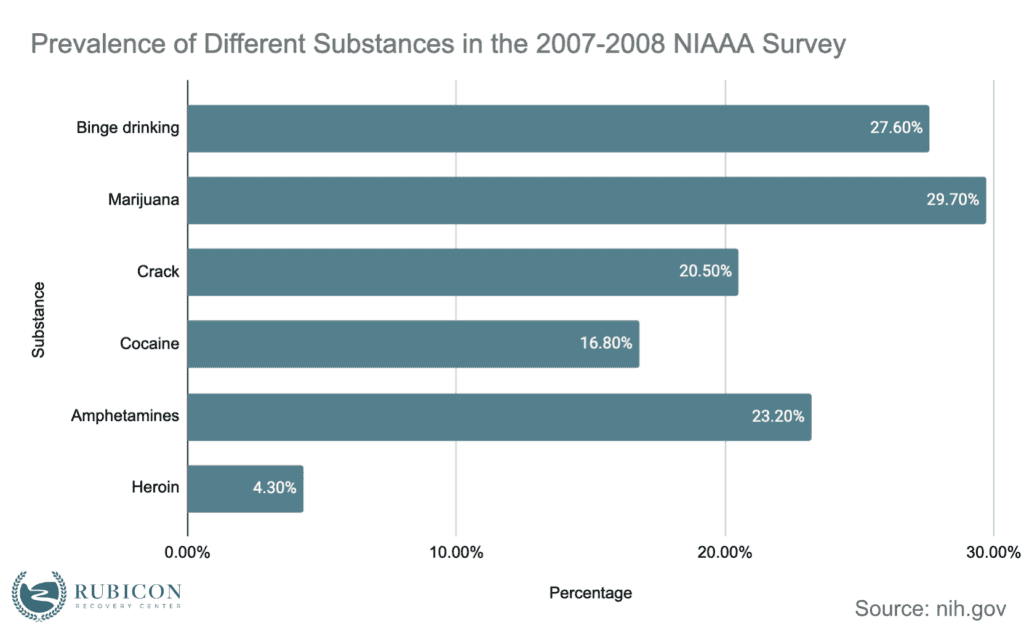
- The NIAAA supported another survey involving 780 homeless women conducted between February and August 2015. The findings revealed that 18.5% reported experiencing an alcohol use disorder in the past year. Additionally, 26% of the sample consisted of women who reported both a substance use disorder and at least one mental health disorder.
- When compared to data from the National Survey on Drug Use and Health for women, the 2015 survey from the NIAAA showed that the probability among this sample of homeless women was:
- Four times higher for serious mental illness
- Five times higher for major depression
- Four times higher for an alcohol use disorder
- 12 times higher for a drug use disorder
Young Adults
- The Research Triangle Institute in North Carolina found that adolescents and young adults aged 12 to 21 who are homeless face a significantly higher likelihood of substance abuse compared to their counterparts who are not homeless.
- According to the Coalition for the Homeless in New York City, homeless single adults exhibit higher rates of serious mental illness, addiction disorders, and other severe health issues compared to homeless families.
- A study published in Drug Alcohol Dependence in 201—which surveyed 305 homeless men in California—revealed that younger men were more inclined to binge drink and use marijuana. It also found that White young adults were notably more likely than African American, Hispanic, or multiracial young adults to use marijuana. Hispanic men had nearly eight times higher odds of using crack than White men.
Homelessness and Addiction Statistics by State
Homelessness and addiction statistics by state include:
Minnesota
- Data from five Essentia Health emergency departments in Northeast Minnesota revealed that out of 459 visits made by patients seeking assistance for substance use or overdose from November 2017 to October 2021, 29% of these patients (134 individuals) were homeless.
- According to Minnesota Drug Overdose and Substance Use Surveillance Activity report 2017–2021:
- 87% of homeless patients treated for overdose or substance use had a history of at least one mental health disorder.
- 25% of homeless patients had a history of involvement with the justice system.
- 90% of homeless patients required hospitalization for substance use-related symptoms or other medical conditions.
- 43% of homeless patients had previously attempted or completed chemical dependency treatment.
- 67% of homeless patients believed they had used amphetamines, while 83% tested positive for amphetamine use.
- 25% of homeless patients believed they had used opioids, while 48% tested positive for opioid use.
California
- As per the HUD, California accommodates 27% of individuals experiencing homelessness and 53% of those without shelter across the United States.
- A 2019 report from the SF Chronicle indicates that around 4,000 residents of San Francisco, with 35% being Black, experience mental illness, homelessness, and addiction. Additionally, 41% of them frequently utilize urgent and emergency psychiatric services in California.
- A study conducted in the Skid Row area of Los Angeles, California, and published in Drug Alcohol Dependence in 2011 discovered that the three most common substances used by homeless men were marijuana (56%), crack (40%), and alcohol leading to intoxication (38%). Other substances showed prevalence rates ranging from 4.77% to 16.79%.
- A study conducted in California from 2016 to 2019 and published in the Journal of Substance Abuse Treatment indicated that people experiencing homelessness (PEH) were notably more prone than non-PEH to use methamphetamine or heroin. PEH also exhibited a higher frequency of primary substance use before seeking treatment, increased utilization of emergency rooms and hospitals, greater involvement in the criminal justice system, and a higher prevalence of mental health diagnoses and unemployment.
Effects of Homelessness and Addiction
Homelessness and addiction affect lives in profound ways. Here are some numbers to show that:
- According to a 2012 study from Veteran Health Association, homeless veterans with opioid use disorder had more health problems, such as HIV, schizophrenia, and alcohol use disorder, compared to non-homeless veterans with opioid addiction.
- People struggling with addiction and additional psychological issues often receive a dual diagnosis. According to the HUD, approximately 20% of homeless individuals in the U.S. suffer from severe mental illness. Up to half of homeless individuals with mental illness also experience a co-occurring substance use disorder.
- According to a joint report from the New York City Departments of Health and Mental Hygiene and Homeless Services in December 2005, substance use and HIV/AIDS were responsible for almost one-third of all deaths among adults who utilized the Department of Homeless Services (DHS) shelter system, in contrast to less than 5% in the broader adult population of New York City.
- The same report mentioned that substance use, alcohol use, and mental illness accounted for 69% of hospitalizations among homeless adults, compared with 10% among non-homeless adults.
- The primary causes of death among adults who used the DHS single adult shelters in 2005, as per New York City Departments of Health and Mental Hygiene and Homeless Services, were as follows:
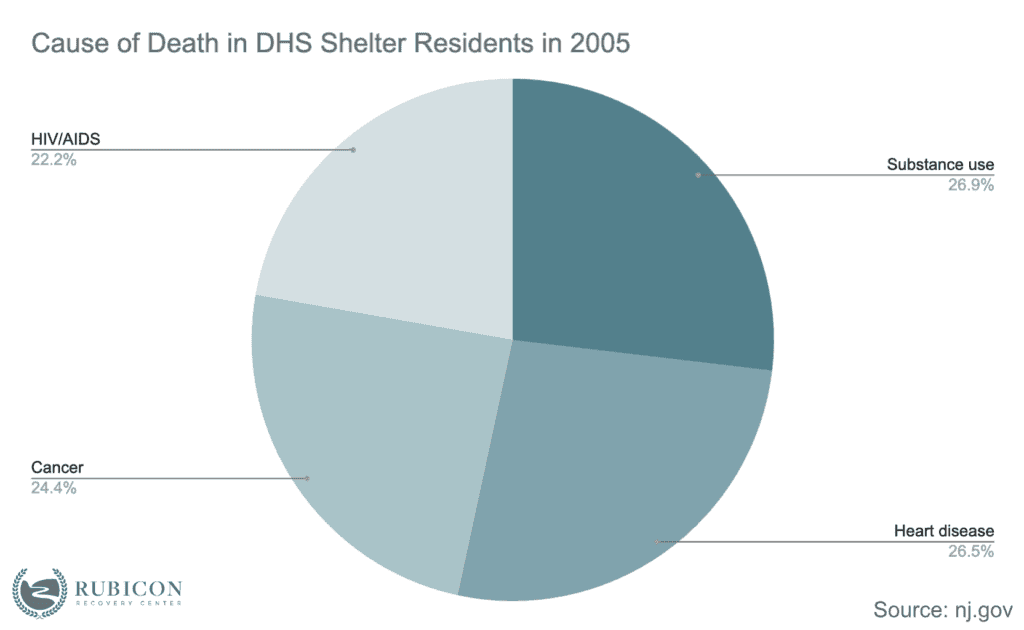
- In 2005, the NASADAD estimated that more than 19.3 million individuals required addiction treatment services but did not receive them. The primary barriers preventing homeless people from accessing treatment were the high expenses and lack of insurance coverage.
Frequently Asked Questions
What Is the Connection Between Substance Abuse and Homelessness?
The National Coalition for the Homeless says that substance use can serve as both a contributing factor to and a result of homelessness.
Substance-dependent individuals find it difficult to maintain stable housing due to financial strains, strained relationships, or inability to fulfill responsibilities.
On the flip side, homelessness exacerbates substance abuse issues. People may turn to drugs or alcohol as a coping mechanism or to alleviate the hardships of life on the streets.
What Percentage of Homeless in the u.s. Are Drug Addicts?
According to the Substance Abuse and Mental Health Services Administration (2003), 38% of homeless individuals in the U.S. are dependent on alcohol, while 26% abuse other drugs. Additionally, HUD’s 2013 Annual Homelessness Assessment Report indicates that approximately 257,000 homeless people in the United States suffer from chronic substance abuse issues.
What Are the Main Causes of Homelessness in America?
The primary causes of homelessness in America include a combination of economic factors such as poverty, lack of affordable housing, and unemployment. Mental illness, substance abuse, and domestic violence also contribute to homelessness.
Other factors include systemic issues like racial inequality, inadequate social support systems, and challenges with accessing healthcare and social services.
Data Sources
- https://americanaddictioncenters.org/rehab-guide/homeless
- https://www.ncbi.nlm.nih.gov/pmc/articles/PMC7023863/
- https://pubmed.ncbi.nlm.nih.gov/23318302/
- https://pubmed.ncbi.nlm.nih.gov/29852450/
- https://pubmed.ncbi.nlm.nih.gov/30044482/
- https://www.ptsd.va.gov/understand/related/substance_abuse_vet.asp
- https://pubmed.ncbi.nlm.nih.gov/23490136/
- https://www.health.state.mn.us/communities/injury/data/mndosanortheast.html
- https://www.coalitionforthehomeless.org/basic-facts-about-homelessness-new-york-city/
- https://www.nyc.gov/assets/doh/downloads/pdf/epi/epi-homeless-200512.pdf
- https://www.sfchronicle.com/bayarea/article/SF-counts-4-000-homeless-addicted-and-mentally-14412061.php
- https://endhomelessness.org/resource/opioid-abuse-and-homelessness/
- https://nationalhomeless.org/wp-content/uploads/2014/06/addiction-Fact-Sheet.pdf
- https://www.samhsa.gov/data/sites/default/files/NSDUHmethodsSummary2013/NSDUHmethodsSummary2013.pdf
- https://files.hudexchange.info/reports/published/CoC_PopSub_NatlTerrDC_2022.pdf
- https://jamanetwork.com/journals/jama/fullarticle/2791941
- https://www.ncbi.nlm.nih.gov/pmc/articles/PMC2743751/
- https://www.ncbi.nlm.nih.gov/pmc/articles/PMC5610631/
Share This Post
